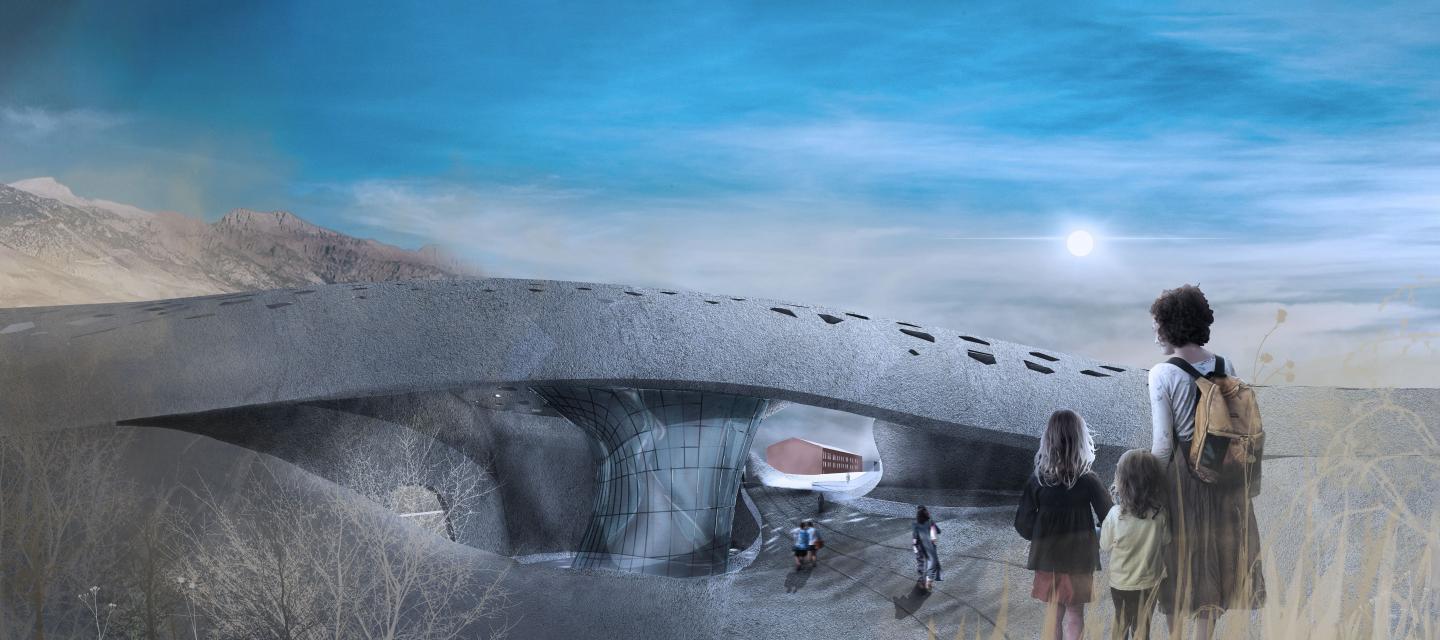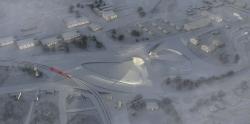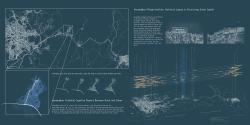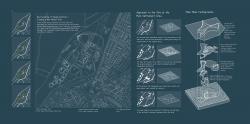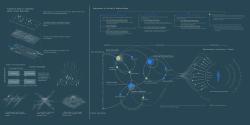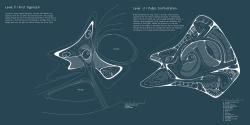Nexus, located at Hasanoğlan, which is a cognitive memory between the countryside and the city, is a reconciliation center that identifies the social problems experienced in rural and urban structures in the new data age and revitalizes the lost social capital between individuals with necessary mediating activities.
*The Concept of Social Capital & its evolution via Urbanizing*
Each individual is cognitively unique considering the environment and mentality he/she is in. As the individual interacts, he/she establishes a communication network and creates his/her knowledge, “Social Capital” from this network. With the development of interactions, societies developed primarily in rural areas, followed by a socio-spatial change from rural to urban. This change weakened the primary relations and made the secondary relations important in which the "individual" was not the main character. Thus, the social capital has been damaged, and the individual has become passive in society or individual actions due to the lack of interaction.
*Hasanoğlan: Potential Cognitive Memory Between Rural and Urban*
Hasanoğlan stands out as a region that can be a mediator in this disconnect between the countryside and the city, as it is a rural settlement in the middle of the vast countryside between the two cities, Ankara and Kırıkkale. The identities of the surrounding also contrast as urban and rural areas, supporting the potential to mediate in between. More importantly, the fact that social initiatives that have a place in the memory of the place in Hasanoğlan have been made is the real potential that makes it important in this context.
*Hasanoğlan Village Institute: Historical Legacy in Structuring Social Capital*
Hasanoğlan's biggest potential social initiative in the context of being a mediator is Hasanoğlan Village Institute. The “Village Institutes”, which was implemented in 1940 in under-developed rural areas of Turkey, was the first social transformation project that gave sociological value to the countryside beyond economic and academic development. In the training provided by these institutes, an academic, as well as real-life adaptable, student-centered pedagogy, was applied, aimed at helping participants realize their full human potential to transform the community they live in. On the other hand, the existing societal values of the rural were encouraged and protected by village institutes such as collaborative formations, self-sufficiency, and productivity. Therefore, village institutes supported the structure and social capital of rural society with the interaction between “researcher” and “rural person”.
*The Disruption of the Social Fabric: Closure of Hasanoğlan Village Institute*
Hasanoğlan Village Institute pioneered many social developments including agriculture, craftsmanship, and literacy including the cooperation culture in the region in its active years.
The co-working system between Hasanoğlan and the institute can be examined as a knitted social fabric. However, after the institute's closure, the abandonment of some of its buildings, and the disappearance of the necessary functions in the region, the values that unite Hasanoğlan as a commune led to the deterioration and fragmentation of the social fabric. This resulted in various societal problems including unemployment, lacking service, a decline in productivity, and corruption of cooperation systems within Hasanoğlan.
*Detecting the needs of the region, initial decisions on generating space*
To overcome the current needs of the region, the data on the existing social structure, the activities, and the current problems of the region were collected. Secondly, a data system was established to record community activity simultaneously; Finally, the needed spaces were created as a reflection of the society, thanks to the data obtained.
In the consideration of spatiality, social capital and knowledge transformation theories were taken into account. Thus, while interactions are encouraged in specific places, social capital in this context is treated as a variable.
This philosophy has come together by deriving from the individual. Thus, modular settlements besides the main building were constructed to examine social data such as relationships, norms, activities, empirical knowledge, and environmental problems on an individual basis. The combination of these modules, and the main Nexus center, created a system of communication within Hasanoğlan Village Institute and beyond. Thus, this network scheme did not remain on a local scale but evolved into a potential that could create an impact area starting from the surrounding regions.
*Descending to the level of “Individual” in Societal Change*
Based on the formation scheme of knowledge in space setup; 3 primary departments emerged that will act as catalysts in the transformation of tacit knowledge into explicit knowledge. The system continued with a data library that would record the transformation process of information and modular units that could descend this system to the level of an individual which has evolved with the pursuit of cognitive, structural, and relational dimensions of social capital.
The main 3 departments are; Socio-Concenter, Communal Metamorphosis, and Cognitive Mediator. The sub-spaces of these departments also intersect among themselves and form a 3-centered co-working system.
Communal Metamorphosis examines social events. As a concurrent researcher identifies social actions and encourages necessary events. Subspaces:
Alter-Agora: An open-air common area that adapts itself and changes in line with the needs of the society, a new square setup for Hasanoğlan.
Co-Decorum: A guild where individuals come together and take initiative on the needs and problems of the region.
Socio Concenter department is responsible for the digital database. It is the center where sociological research takes place in the database. Subspaces:
Cognitive Core: Computer area where the collected data is selected and processed through big data.
Civic-Cyber: A solution space where local people and researchers come together and provide solidarity with the sharing of information.
Co-Network: A place where a cognitive network is created on a local and global scale with the obtained community data.
The Cognitive Mediator department acts as a bridge between human and data, rural and researcher individual. It uses the synthesis of rational and empirical knowledge. Sub Spaces:
Socio-Simulator: This allows residents to take advantage of big data by simulating planned local applications.
Neuro-Empiric: It educates the public by supporting empirical learning at all ages in society with necessary activities and methods.
Collective gen is a data library that keeps the obtained data human and digital. It produces common knowledge by blending the implicit and applicable data of the countryside with the explicit and scientific knowledge of humanity.
Socio-accumulators: While enabling social research to descend to the human level, they activate the "individual" in society. They can be articulated to a building or found singly.
*Repairing the Deteriorated Social Fabric, Decisions on Settlements*
After the Institute was closed, the deterioration in the social fabric was evaluated within the scope of data and information, and the functions that disappeared in each layer were examined. When the layers were overlapped, an analysis of potential locations was obtained that should be focused on to recover lost values. These concentrated areas later evolved into places where program elements could take place.
*The Design Approach: Welcoming, Innovative & Blending with its Surroundings*
Thanks to the analysis obtained, the vertex nodes were determined for the development of the master plan. The reference lines extracted from the lost institute buildings were intersected at the nodes, resulting in a master plan that concentrated the required areas and connected the existing buildings. Thus, Hasanoğlan Village Institute became active again under today's conditions.
Same reference nodes were used to create deformations on the topography to form required spaces. By bulging and caving the topography, two open areas, a cave-like underground space complex and a shell-like structure that unites the whole building complex were created. Therefore the form of the building was designed with the respect to an existing situation. Also by resembling the Elmadağ Mountain next to Hasanoğlan, the building creates familiar scenery for the visitors, and invites them to experience the journey it is offering.
2022
Location: Hasanoğlan / Ankara / Turkey
Total Floor Area at the Main Structure: 10.000 m2
Height: 7m
Master Plan Built-Up Area: 16000 m2
Building Type: Research, Public, Education
Bilge Kösem
Project Instructors:
Assoc. Dr. Ülkü İnceköse &
Assoc. Prof. Dr. Ebru Yılmaz
